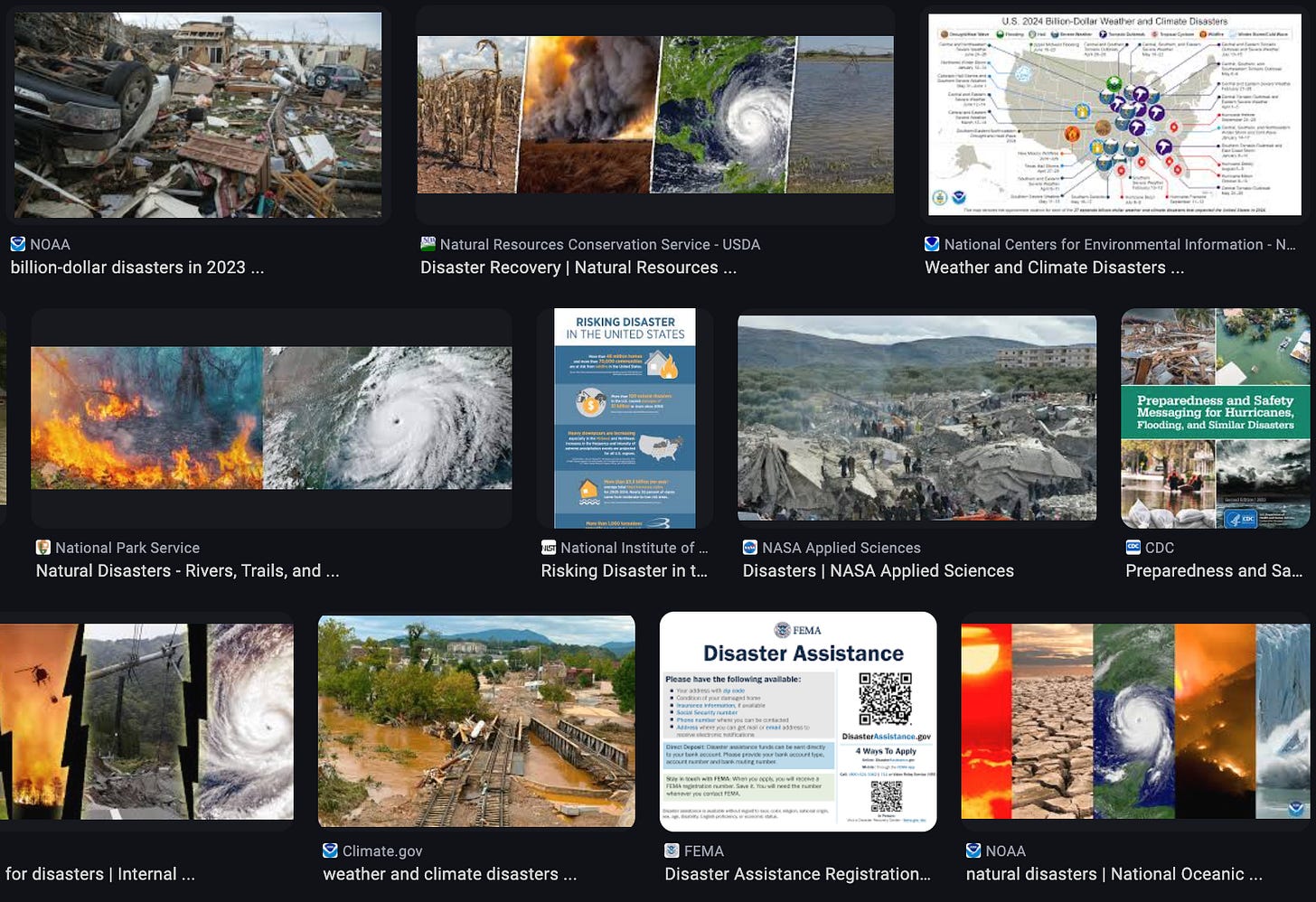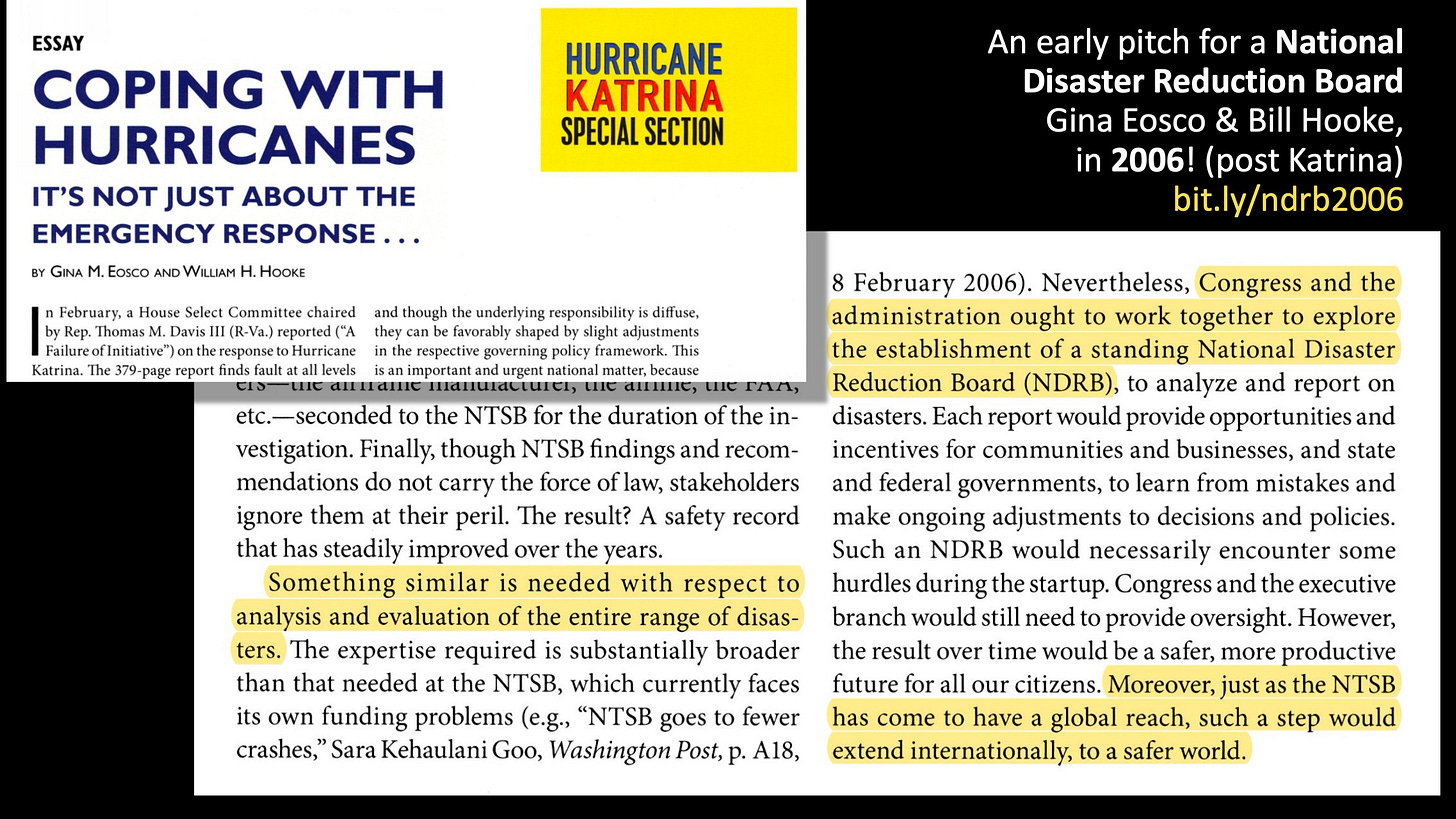When Will We Ever Learn? Calls for a U.S. Disaster Safety Board Keep Piling Up
Without an independent team analyzing disasters, politics and spin will impede paths to a safer, more prepared, society.
Mike Smith, a veteran meteorologist and analyst of extreme weather warning and response, has just renewed a call he’s been making since 2012 for a national disaster review board. Click here to read his original proposal (part 1, part 2).
My friend
has just published a guest post from Smith laying out his updated argument. You can read an excerpt below and follow the link to the full commentary. I interviewed Smith about this as the Hurricane Helene disaster response was playing out. Here’s the key section.Here’s some vital background to set the scene.
No natural disasters
As you likely know if you’ve been following me for awhile, there are no natural disasters. Here’s self-described “disasterologist”
explaining why - clipped from a fantastic Miriam Nielsen Zentouro video.A hazard spawns a disaster if societal and physical structures and capacities can’t absorb the jolt. Consider the paths from pathogen to pandemic, from flash flood to city basement drownings, from wildfire to urban firestorm. Here’s a relevant post of mine on shaking out vulnerabilities to limit the losses when the worst happens.
How aviation safety benefits from independent review
As you also may know, along with my decades of reporting on sustainability challenges, I’ve written off and on about calamitous disasters - both from natural hazards like earthquakes and technological failures like the horrific midair explosion that destroyed TWA Flight 800 on July 17, 1996. While the world (including The New York Times newsroom) was fixated on the possibility that Boeing 747 and 230 lives were destroyed in an act of terror, months and then years of analysis pointed to some complex layering of failures involving eletrical systems and fuel tanks. The entity that led that analysis was the National Transportation Safety Board - a keystone source of ever-safer aviation and other transportation practices through methodical assessments of disastrous events and recommendations for improvements.
As the NTSB’s brilliant current chair, Jennifer Homendy, explained after the East Palestine, Ohio, train derailment and toxic fire, just as there are no natural disasters, “there are no accidents.”
The Board is hard at work right now on the recent series of aviation disasters - in a process that, in its independence, can avoid the politicization and conspiracy mongering around such tragedies.
The urgent need for all-hazards disaster review
With all of this in mind, for years I’ve been tracking and endorsing a series of calls for the creation of an independent United States National Disaster Safety Board (or Review Board depending on the particular proposal).
The earliest such call I can find came in 2006, after Hurricane Katrina, from weather risk communicators Gina M. Eosco (working for many years at NOAA on improving weather forecast responsiveness) and William H. Hooke of the American Meteorological Society (behind paywall). Here’s the key section:
In 2021, Anna Weber of the Natural Resources Defense Council posted on efforts to pass legislation creating such a board. She wrote:
There is no standardized, federal process by which disaster-related efforts are evaluated across multiple agencies and levels of government. Instead, at best, we have after-action reports (AARs), in which agencies evaluate their own performance during. Earlier this year, a group of public health experts investigated reports from Hurricanes Katrina, Rita, and Harvey and determined that “[b]ecause of the lack of objective data, inconsistent format, unevenly distributed content, and lack of adherence to any framework, AARs are fraught with shortcomings.” The authors conclude that an NDSB is needed “so that objective evidence drives meaningful enhancements in lifesaving disaster response.”
Given the relentless pace of climate-fueled disasters, it is particularly critical to assess how policies and programs serve (or, too frequently, fail to serve) low-income communities, communities of color, and others disproportionately burdened by the effects of these events. The proposed NDSB will have a special focus on these disproportionately impacted communities, as part of a broader mission that prioritizes human lives over economic value—in other words, people over property.
Bipartisan legislation to create such a disaster review and safety board has been pushed several times. This post by BPC Action describes the effort (which has not gained traction despite the logic):
BPC Action commends the bipartisan collaboration in the House and Senate to reintroduce legislation that would establish a new National Disaster Safety Board. The National Disaster Safety Board Act of 2021, introduced by Reps. Katie Porter (D-CA), Nancy Mace (R-SC), and John Garamendi (D-CA), and the Disaster Learning and Life Saving Act, introduced by Sens. Brian Schatz (D-HI) and Bill Cassidy (R-LA), would create an independent board to study the causes of disaster-related fatalities and property damage across the nation.
Each year millions of Americans’ lives are upended by increasingly catastrophic weather events and natural disasters. In 2021 alone, the U.S. experienced 20 major disasters, resulting in $145 billion in damages and 688 deaths. From Atlantic hurricanes to Western wildfire seasons to flooding in the Midwest, disasters have been particularly destructive in the last few years, setting records for all the wrong reasons.
These pieces of legislation, drafted with input from members of BPC’s Task Force on Disaster Response Reform, would empower policymakers to better understand the underlying causes behind fatalities and property damage resulting from disasters. A new National Disaster Safety Board would fill a gap that currently exists today in the execution, standardization, dissemination, and implementation of after-action reviews and investigations, insulating important fact-finding from political pressure and leading to the development of evidence-based best practices.
After Hurricane Ian in 2022, a trio of disaster risk and policy experts, including Sam Montano, published this commentary in The Hill: Hurricane Ian is proof: The US needs a national disaster safety board. The other authors were Scott Gabriel Knowles, a professor in the Graduate School of Science and Technology Policy at the Korean Advanced Institute of Science and Technology and Njoki Mwarumba, then an assistant professor of Emergency Management and Disaster Preparedness at the University of Nebraska Omaha. Together, they and Montano founded Disaster Researchers for Justice - a key source of insights on the social factors underlying disaster impacts. Here’s a converastion I did with Montano on this issue and opportunity:
Amid a Barrage of Climate Calamities, "Disasterologist" Samantha Montano Puts the Focus on Disaster [In]Justice
UPDATED post show: Given this year’s continuing string of unnatural disasters, a late-season hurricane poised to be a threat in the Gulf of Mexico, and the incoming Trump administration seemingly deadset on disrupting the Federal Emergency Management Agency and National Oceanic and Atmospheric Administration, it’s high time to visit with a disaster poli…
Can we handle the truth?
Given all of these arguments in favor of a nonpartisan disaster review process, you’d think we’d have such a mechanism by now. But just think about what such a process would reveal - the full systemic set of factors contributing to calamities. It’s an accountability machine. Politicians and communities and companies don’t like that much. Nonetheless it’s vital to keep up the push. I’ll happilly do more Sustain What webcasts on this in the months ahead.
An expert in extreme-weather safety weighs in anew
Here’s a key takeaway section from Mike Smith’s latest proposal for a disaster review board over on
:When a major disaster presents itself, a “go team” from the DRB would quickly go to the site and the subject matter experts will collect perishable data. At the same time, weather forecasts and warnings, plus internal communications by local emergency management and related entities (if applicable) would be collected.
Once the disaster’s immediate effects have passed, interviews of people affected by and handling the disaster will be conducted. The DRB would have subpoena power but no law enforcement role. Like the NTSB, its findings will not be eligible to be entered into litigation, to encourage witnesses to be candid.
Similar to the NTSB’s procedures, the DRB’s would produce a preliminary analysis. The next step is public hearings will be held with additional evidence gathered. After, a final report will be published and distributed. If desired, testimony by the DRB would be provided to Congress, the president, and relevant agencies to share any recommended changes to federal policy or implementation.
A DRB will have two other important tasks:
Today, if an engineer is tasked with designing a new general aviation aircraft and wants to learn about, say, icing occurrences, accessing the NTSB’s database is easily accessible. There is no similar database or central repository of expertise in the field of disaster management. The DRB will be tasked with creating one.
In addition, the Disaster Review Board should also be tasked with independently keeping accuracy statistics of the National Weather Service’s storm forecasts and warnings. Currently, the NWS keeps its own statistics and investigates its own performance during disasters — creating an obvious conflict of interest.
While it will take time to make a major difference, an independent DRB is the only way we can begin to systematically understand the root causes of major disasters the United States and develop sensible options to reduce the chances of recurrence.
Consider: If the lessons that a Disaster Review Board might learn from the LA fires led to a reduction of just 2% of the economic losses caused by future fires, that would total billions of dollars. Given an annual budget of roughly $70 million, a DRB would produce a huge return on investment along with saving lives. Again, the NTSB provides a model to emulate.
Read the rest:
That point at the end, the huge potential savings from a modest investment, is just one key argument to make to your legislators.
And subscribe to Mike Smith’s blog!
Kicker
When my wife Lisa Mechaley was teaching middle school science, her colleague Mike Topchik devised a cost/benefit assessment to go with their classic balsa bridge-building-and-breaking lesson plan. Kids had to build bridges with durability and cost weighed in their designs. If they can do it, why can’t we all do a better job designing our communities and infrastructure with disaster in mind? As a takeway, here’s a video of their culminating competition and my old Dot Earth post.





![Amid a Barrage of Climate Calamities, "Disasterologist" Samantha Montano Puts the Focus on Disaster [In]Justice](https://substackcdn.com/image/fetch/$s_!YaXt!,w_1300,h_650,c_fill,f_auto,q_auto:good,fl_progressive:steep,g_auto/https%3A%2F%2Fsubstack-post-media.s3.amazonaws.com%2Fpublic%2Fimages%2F6f39a4e3-29c5-427a-b1f5-5eafce7b264b_1664x1462.jpeg)

Presumably some people are afraid that the results WOULD be politicized. Could the NTSB be established in today’s political climate? The question is how to get around that concern.
At a micro level, good insurance underwriting can create the proper incentives to design vulnerable assets in a cost-effective way. [https://thomaslhutcheson.substack.com/p/climate-risk-and-insurance]
Hi
As you are not already a subscriber, may I invite you to subscribe (for free) to my substack, "Radical Centrist?"
https://thomaslhutcheson.substack.com/
I write mainly about US monetary policy, US fiscal policy, trade/industrial policy, and climate change policy.
I have my opinions about which US political party is by far the least bad and they are not hard to figure out, but I try to keep my analysis of the issues non-partisan.
Keynes said, “Madmen in authority, who hear voices in the air, are distilling their frenzy from some academic scribbler of a few years back.”
I want to be that scribbler.
Thanks,